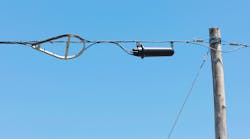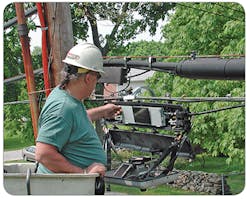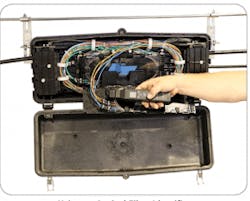When considering distribution of information on fiber optic cable in a splice closure, three types of splicing should be considered including above ground aerial, at grade or below grade fiber optic splicing. Each of these splicing types has benefits as well as cost and risk associated with deployment. This white paper defines considerations for slack loop aerial fiber optic splicing in risk, cost and reward. These comparisons will be limited to backbone and branch distribution in splice closures.
OUTSIDE PLANT CONSIDERATIONS
Three types of fiber optic splice closures should be considered with aerial splicing used in two broad applications:
Traditional slack loop cable splicing is the most common deployment. A coil of fiber optic cable is placed and the splice closure will be installed by another crew. This allows the cable to be opened and spliced to branch cables or cable ends. This type of splicing can utilize either a sealed splice closure or a weather-tight breathable splice closure for all splicing.
Taut sheath or no slack splicing occurs when there is a repair to a fiber optic cable damaged on the strand or when a no slack branch or drop cable is to be installed. This type of splicing can only be accomplished with an inline splice closure and typically occurs after plant design and deployment. This is a cost-effective solution for repair or additional branch drops.
Sealed Splice Closure
Aerial Weather-tight Splice Closure
DRIVING FACTORS IN FIBER OPTIC SPLICE CLOSURE SELECTION FOR SLACK LOOP SPLICING
When defining what type of splice closure will best suit the deployment and maintenance expectations of a provider, consider these factors.
- Initial cost of goods — material needed to install and maintain the plant
- Initial cost of installation — labor cost for first pass placement and splicing
- Deferred cost of installation — material and labor costs in a "build as you grow" design
- Routine maintenance and repair — material and labor associated with environmental and accidental damage associated with outside plant fiber optic cable deployment
- Ease of expansion — material and labor cost associated with expansion (internal or external geographic expansion)
- Choosing the right material
• Proven and supported product
• Meets applicable industry standards
• Material availability and warehousing considerations
• Training time for current staff, contractors and future training
The process of installing any type of splice closure in an aerial application has many constants which will not change based on the type of splice closure deployed. These include site preparation, cable preparation and actual splicing where applicable.
InvisiLight® Solution for Deploying Fiber
April 2, 2022Go to Market Faster. Speed up Network Deployment
April 2, 2022Episode 10: Fiber Optic Closure Specs Explained…
April 1, 2022Food for Thought from Our 2022 ICT Visionaries
April 1, 2022COST CONSIDERATIONS
Many manufacturers provide fiber optic splice closures in both sealed and weather-tight varieties. Consider the following:
- The cost of a weather-tight splice closure is typically less than a sealed splice closure.
- No special tools are required for installing a weather-tight splice closure.
- Initial training and new hire training times are reduced with weather-tight splice closures.
- Sealed splice closures typically have more associated kits.
- Sealed splice closures are a universal product that can be used in any splicing location.
- Weather-tight splice closures are limited to aerial strand locations.
The variable costs associated with the different types of aerial splice closures are highlighted below:
INITIAL FIRST PASS LABOR
Installation of a Weather-Tight Aerial Splice Closure
The majority of this cost is labor spent on constants that remain stable between both types of splice closures. The cable placement and coil lengths are constant. The setup and splicing at each location is constant on the first pass as sealed and weather-tight splice closures can both be spliced at grade level. However, there is an opportunity to decrease time spent in low to mid-count splicing by splicing on the strand in a weather-tight splice closure. This is not possible in a sealed splice closure. Current fusion splicers are designed to withstand the weather in an outside plant deployment where strand aerial splicing can be a consistent time and cost-saving methodology. This should be an area of risk versus reward depending on weather and technician proficiency.
The study below can be used 2 ways:
1. At-grade splicing can occur on both sealed and weather-tight splice closures.
2. Aerial splicing can occur only in weather-tight splice closures.
Aerial splicing in a slack loop-type design does not require special equipment to perform at the bucket. Considerations of environmental protection such as tents and heaters can improve productivity but are not required to perform the splicing. As mentioned above, taut sheath no slack splicing will require specific strand mount bracketry for the fusion splicer.
BUILD AS YOU GROW
Build as you grow is applicable in a phased build where branch cables are deployed after an initial backbone build and implemented as service is needed in a specific region. This time savings listed above would be applicable for each branch added to an existing coil left on the backbone cable. Sealed splice closures must utilize at grade splicing to add a branch to the backbone. Weather-tight splice closures can be spliced at grade or on strand.
ROUTINE MAINTENANCE
The cost savings of utilizing weather-tight aerial splice closures is one that can be realized for the life of the plant. There are many times when a splice closure needs to be opened other than splicing. Routine maintenance, troubleshooting and repair occur on a regular basis in outside plant fiber networks. Routine maintenance can include preventive replacement or repair of fiber for squirrel chews or low lying branches. The need for outside plant fiber repair can come from many places, including nature and man-made repairs; hunting season and the marksman who takes your fiber rather than the bird on the strand, an unfortunate car or truck accident involving a pole or strung fiber, and finally Mother Nature can cause the most havoc to the plant with an arsenal of wind, snow and ice.
Weather-Tight Aerial Splice Closure
Using an Optical Fiber Identifier on the Weather-Tight Aerial Splice Closure
From an OTDR to red light fiber verification, a weather-tight aerial splice closure will save money. A typical trouble call can result in multiple splice closure openings to troubleshoot and repair an outage. The aerial option can be accomplished in half the time potentially performing the maintenance from a ladder eliminating the need for a costly bucket truck roll out.
TRAINING AND CRAFT PREPARATION
Typically, a weather-tight splice closure is not as complicated to install as a sealed splice closure installation. A weather-tight splice closure is designed to be more tolerant of field and craft variations during installation as it contains fewer parts and is less complex. Training craft personnel or contractors is significantly less than a sealed splice closure. The weather-tight splice closure installation does not need to be sealed to prevent the Telcordia-specified 20 feet of water out for seven days. Typically special tools are not needed and often use fewer tools than a sealed splice closure.
SUMMARY
What are the benefits of aerial splicing for you and your company? The benefits of time and cost savings are clearly defined above, but what are the other considerations in adopting this technology? The aerial weather-tight (breathable) splice closures have a 20+ year proven field record with products from multiple vendors. The deployment of this technology has spanned all of North and Central America with proven protection in the harshest of environments from the cold of Northern Canada to the heat in Mexico. These have been approved and deployed in all markets and fiber plant designs from RBOC to ITEC and CATV providers. From an RBOC perspective, breathable closures are recognized as telephony-grade solutions verified in GR-771 for free-breathing splice closures.
The benefits and cost savings continue as your fiber plant matures with decreased maintenance cost due to ease of field troubleshooting and plant repair or expansion utilizing weather-tight splice closures. By design the weather-tight splice closure allows for ambient temperature and ambient humidity inside the splice closure as well as outside the splice closure. This prevents condensation from forming inside the weather-tight splice closure which ultimately would be sealed in the traditional splice closure.
In areas where freezing is a concern, this closure is proven to have additional value. If condensation, moisture or rain were to migrate into a sealed splice closure the accumulation of frozen water can result in attenuation or total failure of optical links in the field. This cannot occur with a vented closure and fiber routing design in a weather-tight splice closure.
The design of a weather-tight splice closure prevents water from ever being able to accumulate and reach the fiber cable or splice sleeve, preventing an attenuation or degradation that can occur from bare fiber being submerged in water for extended periods of time.
In terms of material, labor and maintenance cost, the deployment of aerial splicing is proven to be a reliable cost saving strategy for outside plant fiber placement.
About the Author: Rich Megill is the Applications Engineering Manager for AFL’s Optical Connectivity and Apparatus (OCA) division. With more than 30 years of experience in fiber optic technology, Rich started his career with Keptel, a division of ARRIS, where he designed network interface systems and fiber optic cable management products for telco residential and commercial applications. For more information, visit www.AFLglobal.com.
This article contains excerpts from the AFL white paper Benefits of Aerial Splicing. CLICK HERE to download the complete white paper and to discover all of the benefits of aerial splicing.















